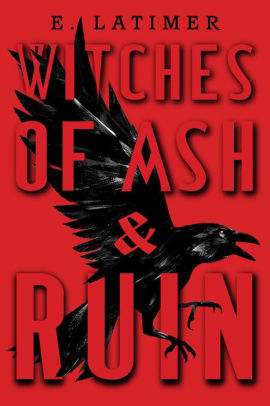Fiction Revelations: How Writing a Book about Witches and Murder Got Me My OCD diagnosis, a guest post by E. Latimer
The problems began in kindergarten.
Near the start of the year, I apparently got myself locked in the school bathroom, my five-year-old self fumbling with a sticky door that wouldn’t come unlatched. I don’t remember this event, but I do remember what came after. This experience seemed to break something in my brain. I spent the next year simultaneously terrified to go into those bathrooms, and totally convinced I had to go.
Over the following days and weeks, this fixation became absolute. No matter how much or how little water I would drink, it was a constant thought in the back of my mind. It became so bad that my parents took me in for “explorative surgery” to see if something was physically wrong with me.
ADVERTISEMENT
ADVERTISEMENT
There was nothing.
In my early teens, this strange, embarrassing obsession began to fade. But my relief was short-lived. Rather than disappearing altogether, the intense focus seemed to shift. Now, instead of constantly wondering if I really had to go, or it was just my imagination, I was suddenly fixated on my breathing instead.
Multiple times throughout the day I would notice it and begin to “accidentally” regulate my own breathing. I would worry I wasn’t breathing deeply enough, I wasn’t getting enough oxygen. I was overcome by the idea that I kept noticing my breath, that I would never stop noticing.
Whenever I tried to tell my parents, none of my explanations made sense. No, I wasn’t worried I’d stop breathing, not exactly. Yes, I knew I was still actually breathing because I’d be passed out if I wasn’t. Yes, I knew it was all ridiculous.
The “breathing thing” as I called it, continued on into adulthood. Eventually I went to a doctor, who gave me nasal spray. Then another doctor, who told me it was GAD. Then a psychologist, and then another. More GAD diagnosis. Nothing really made sense, and finally, I simply gave up.
Sometimes the obsession would retreat for a while, and I’d feel almost normal. I’d go for months like that, thinking I was okay. And then something would trigger it, and it was back into another endless cycle of obsession. It ate up weeks of my life, including an entire vacation at a beautiful resort, where I spent seven full days trapped in my own head, wrestling with this obsession (I hardly remember anything about that trip).
Each time I’d think about trying to get help for it, I’d remember the doctors and psychologists I’d already seen, and how hard it was to explain this, and I’d give up all over again.
Then, a little over two years ago, I was talking to a good friend, L.D. Crichton, author of All Our Broken Pieces, and she mentioned that the book she was currently writing was something she was very emotionally attached to, that she was putting all her fear and worries and anxiety onto those pages, and it was an incredible feeling.
It felt like something in me woke up at that moment, a strange, intense kind of need, and all I could think was, I want that.
But I wasn’t sure how to do that. I’m a fantasy writer. I write about magic. Wizards and witches and portraits that come alive and try to murder people. Where in this type of work, did mental health fit?
The book I was working on in that moment was about rival covens in Ireland. It was about witches, yes, but it was set in contemporary times, which made me think, why not? Why couldn’t I put all my mental health struggles into my main character? The anxiety, the doctors, the psychologists, the frustrations of not feeling like your diagnosis matches.
And so I did.
The process was intense, to say the least. It was simultaneously relieving and triggering. I would write for long hours and then have to take breaks for a few days, just to pull myself out of my own head. But once it was all done and on the page, it felt like a triumph. Like I had overcome my anxiety and triggers and written this book, and that was truly a feat.
But as I finished, and began to read it over with revisions in mind, there was something else aside from my triumph I was feeling, a kind of growing certainty that I’d never had before. Rereading bits of the narrative, my character’s thoughts and feelings, made it clearer than it had ever been. The doctors had been wrong. The psychologists had been wrong. This was not panic disorder, or general anxiety disorder, or PPD, as one psychologist tried to diagnose me with after the birth of my child. None of those things fit. None of them made sense. I had been talking to one professional after another, but none of them had listened. Not really.
After this realization, I dove into research with a newly found fire. Article after article, online forums and facebook pages and twitter threads. I searched all the keywords I could possibly think of. And finally I hit on something that seemed to match. Something that described me with alarming accuracy.
Determined, I went hunting through psychologists, and found one who specialized in OCD. An expert in this specific area.
It took one session with him. A short initial interview, and an on paper test that I ticked off—yes, yes, yes, yes, all of the above—and that…was that.
Somatic OCD. A subtype of OCD focused on autonomic, or non-conscious body processes and functions.
I stumbled out into the bright sunshine after the session, a little stunned. It felt surreal, having lived with this since the age of five, and just now finally getting confirmation that yes, I was right. Yes, I wasn’t overreacting or imagining things. I felt complete and utter relief.
I would feel other things later. Anger, that I’d lost so much time to this obsession. Hurt, that I’d never been able to articulate myself properly to my family. Indignation, that our mental health system had allowed me and so many others to slip through the cracks…
But I think I’ve finally settled in a good place. Witches of Ash and Ruin not only helped me get my diagnosis, I can now use it to connect with readers like me. People who are struggling to understand what’s happening to them. People who aren’t aware that OCD can look radically different in different people. And people who are just hungry to see themselves in a fantasy novel, which many of us with mental illnesses never get to experience.
And I will forever be grateful to the writing experience that led me here. I finally have help. Confidence. Clarity. It just took twenty-seven years and a book about murderous Irish Gods and sapphic witches in order to get here.
Meet E. Latimer

E. Latimer is a fantasy writer from Victoria, BC. Her middle grade novel, The Strange and Deadly Portraits of Bryony Gray was published by Tundra Books, and was nominated for the Red Maple Fiction Award.
In her spare time, she writes books, makes silly vlogs with the Word Nerds about writing, and reads excessively.
Her latest novel, Witches of Ash and Ruin, was released March 3rd from Little Brown.
Find out more at http://www.elatimer.com/
About Witches of Ash and Ruin

ADVERTISEMENT
ADVERTISEMENT
Modern witchcraft blends with ancient Celtic mythology in an epic clash of witches and gods, perfect for fans of V.E. Schwab’s Shades of Magic trilogy and CHILLING ADVENTURES OF SABRINA.
Seventeen-year-old Dayna Walsh is struggling to cope with her somatic OCD; the aftermath of being outed as bisexual in her conservative Irish town; and the return of her long-absent mother, who barely seems like a parent. But all that really matters to her is ascending and finally, finally becoming a full witch-plans that are complicated when another coven, rumored to have a sordid history with black magic, arrives in town with premonitions of death. Dayna immediately finds herself at odds with the bewitchingly frustrating Meiner King, the granddaughter of their coven leader.
And then a witch turns up murdered at a local sacred site, along with the blood symbol of the Butcher of Manchester-an infamous serial killer whose trail has long gone cold. The killer’s motives are enmeshed in a complex web of witches and gods, and Dayna and Meiner soon find themselves at the center of it all. If they don’t stop the Butcher, one of them will be next.
With razor-sharp prose and achingly real characters, E. Latimer crafts a sweeping, mesmerizing story of dark magic and brutal mythology set against a backdrop of contemporary Ireland that’s impossible to put down.
ISBN-13: 9781368052252
Publisher: Little, Brown Books for Young Readers
Publication date: 03/03/2020
Age Range: 14 – 18 Years
Filed under: Uncategorized
About Amanda MacGregor
Amanda MacGregor works in an elementary library, loves dogs, and can be found on Twitter @CiteSomething.
ADVERTISEMENT
ADVERTISEMENT
SLJ Blog Network
One Star Review, Guess Who? (#202)
Review of the Day: My Antarctica by G. Neri, ill. Corban Wilkin
Exclusive: Giant Magical Otters Invade New Hex Vet Graphic Novel | News
Parsing Religion in Public Schools
ADVERTISEMENT







